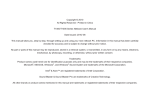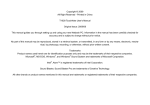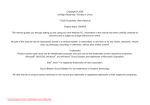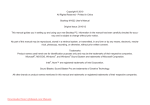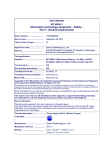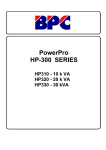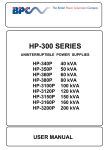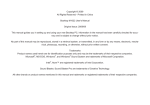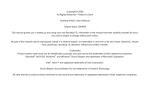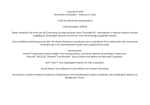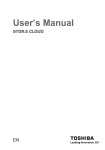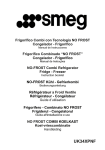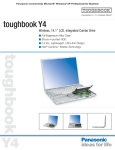Download Printed in China T1000 TouchNote User`s Manual Date Issued: 2010
Transcript
Copyright © 2010 All Rights Reserved - Printed in China T1000 TouchNote User's Manual Date Issued: 2010/ 01 This manual takes you, step by step, through setting up and using your new Netbook PC. Information in this manual has been carefully checked for accuracy and is subject to change without prior notice. No part or parts of this manual may be reproduced, stored in a retrieval system, or transmitted, in any form or by any means, electronic, mechanical, by photocopy, recording, or otherwise, without prior written consent. Trademarks Product names used herein are for identification purposes only and may be the trademarks of their respective companies. Microsoft®, MS-DOS, Windows®, and Windows® Sound System are trademarks of the Microsoft Corporation. Intel® & Atom™ are registered trademarks of Intel Corporation. Sound Blaster & Sound Blaster Pro are trademarks of Creative Technology. All other brands or product names mentioned in this manual are trademarks or registered trademarks of their respective companies. Safety Instructions Use the following safety guidelines to help protect you and prevent damage to your touchnote. English I When Using Your T1000 TouchNote Computer CAUTION: Notebooks generate heat while in use and this can build up in the base of the notebook. When using the notebook please be careful and do not rest the notebook on exposed skin as contact with the base can cause serious discomfort or a serious skin rash or burn. •Do not attempt to service the TouchNote yourself. Always follow installation instructions carefully. •Do not carry a battery in your pocket, purse, or other container where metal objects (such as car keys) could come into contact with and short-circuit battery terminals. The resulting excessive flow of current would cause extreme temperatures and result in excessive burns or a possible fire or explosion. •Be sure that nothing rests on your AC adapter's power cable and that the cable is not placed where it can be tripped over or can be stepped on and damaged. •While you are using the computer or charging the battery, place the AC adapter in a ventilated area, like on a desktop or on the floor while it is charging as this may prevent ventilation and cause the adapter to overheat. Do not use the AC adapter while it is inside a carrying case. •Do not insert objects into the air vent of your TouchNote computer. Doing so can cause short-circuiting and may result in fire or electrical shock. This will also hamper vantilation. •Use only the AC adapter and batteries that are supplied by your TouchNote manufacturer. Using other types of battery or AC adapter may heighten the risk of fire or explosion. •Incorrectly inserted batteries may result in an explosion. •Replace only with the same or compatible battery recommended by the manufacturer. •Please discard used batteries according to the manufacturer's instructions. •Before you connect your TouchNote to a power source, ensure that the voltage rating of the AC adapter matches that of the available power source. -115 V/60 Hz in most of North and South America and some Far Eastern countries such as South Korea. -100 V/50 Hz in eastern Japan and 100 V/60Hz in western Japan. -230 V/50 Hz in most of Europe, the Middle & Far East and Africa. •If you use an extension cord with your AC adapter, ensure that the total ampere rating of all devices plugged into the extension cord does not exceed its total capacity. •When removing battery from your TouchNote, first turn off the system, disconnect the AC adapter from the electrical outlet, and then remove the battery. •To avoid risk of an electrical shock, do not connect or disconnect any cables, or perform maintenance or reconfiguration of this product during a thunderstorm. •Do not throw batteries into fire, doing so may cause an explosion. Check with local authorities first for battery disposal instructions. •When setting up your TouchNote for work, place it on a level surface. •When traveling, do not check your TouchNote as baggage. You can put your TouchNote through an X-ray security machine, but never put your TouchNote through a metal detector. If you have your TouchNote checked by hand, be sure to have a charged battery ready in case you are asked to turn on your TouchNote. T1000 TouchNote USER’S MANUAL NOTICE: When taking your TouchNote from a colder to a warmer environment or vice versa, allow your TouchNote enough time to adapt to the new environment before switching the notebook on. •When unplugging the power cord, please make sure that you pull on its connector or on its strain relief loop, and not on the power cord itself. As you pull out the connector, please ensure that it is pulled out evenly in order not to bend its connecting pins. Also, before you connect the power cord, make sure that both connectors are correctly oriented and aligned. •Before you clean your TouchNote, turn it off first, unplug it from its power source, and remove the battery. •Handle interior components with care. When removing a component, please hold it by the edge and not on the connecting pins (such as the memory module). When using your telephone equipments, safety instructions should always be followed in order to prevent fire, electrical shock or injuries, these instructions include: •Do not use this product near water, for example, near a bathtub, washing basins, kitchen/laundry sinks, wet basements or swimming pools. •Avoid using cordless phones during an electrical storm as lightening may cause electrical shocks and damange. WARNING: Voiding the Warranty * If the battery is not properly handled, there may be a risk of explosion; make sure you are using the same or compatible battery. * Please discard used batteries according to the instructions given by the manufacturer. * Please be aware that use of cracked, severely scratched or poor quality discs may damage the optical drive and corrupt data in the disc. Such discs may break while inside the optical drive and may damage the drive and may void the notebook warranty. English •When traveling with the hard drive removed from your TouchNote, wrap the drive in an insulated material, such as cloth or paper. If you have the drive checked by hand, you may be asked to install the drive into your TouchNote. Your can have the hard drive checked through an X-ray machine, but never put the drive through a metal detector. •When traveling, do not place your TouchNote in the overhead storage compartment where it could shift around. Do not drop your TouchNote or subject it to other mechanical shocks. •Protect your TouchNote, battery, and hard drive from all types of henvironmental hazards that it may be exploded to during use or while being transported. •When you move your TouchNote in environments where there is a substantial difference of temperature or humidity level, condensation may form on or within your TouchNote. To avoid damaging your TouchNote, please allow sufficient time for the moisture to evaporate before continue using. II Regulatory Notices Federal Communications Commission Notice English III This equipment has been tested and found to comply with the limits for a Class B digital service, pursuant to Part 15 of the FCC rules. These limits are designed to provide reasonable protection against harmful interference in a residential installation. Any changes or modifications made to this equipment may void the user’s authority to operate this equipment. This equipment generates, uses, and can radiate radio frequency energy. If not installed and used in accordance with the instructions, may cause harmful interference to radio communications. However, there is no guarantee that interference will not occur in a particular installation. If this equipment does cause harmful interference to radio or television reception, which can be determined by turning the equipment off and on, the user is encouraged to try to correct the interference by one or more of the following measures: ●Reorient or relocate the receiving antenna. ●Increase the separation between the equipment and receiver. ●Connect the equipment into an outlet on a circuit different from that to which the receiver is connected. ●Consult the dealer or an experienced radio/TV technician for help. ●All external cables connecting to this basic unit must be shielded. For cables connecting to PCMCIA cards, see the option manual or installation instructions. RF exposure This equipment must be installed and operated in accordance with provided instructions and must not be co-located or operating in conjunction with any other antenna or transmitter. End-users and installers must be provide with antenna installation instructions and transmitter operating conditions for satisfying RF exposure compliance. SAR Value:0.323 W/Kg T1000 TouchNote USER’S MANUAL CE Notice (European Union) • EN 55022 — “Limitations and Methods of Measurement for the Radio Interferences of Information Technology Equipment.” • EN 55024 — “Information technology equipment - Immunity characteristics - Limits and methods of measurement.” • EN 61000-3-2 — “Electromagnetic compatibility (EMC) - Chapter 3: Limits - Section 2: Limits on the harmonic current emissions (Equipment input current up to and including 16 A per phase).” • EN 61000-3-3 — “Electromagnetic compatibility (EMC) - Chapter 3: Limits - Section 3: Limits on the voltage fluctuations and flicker in low-voltage power supply systems for equipment with rate current up to and including 16 A.” • EN 60950 — “Safety of Information Technology Equipment.” NOTE: EN 55022 emissions requirements provide for two classifications • Class A governs commercial use • Class B governs residential use For CB: • Only use batteries designed for this computer. The wrong battery type may explode, leak or damage the computer • Do not remove any batteries from the computer while it is powered on. Battery Disposal & Caution The product that you have purchased contains a rechargeable battery. The battery is recyclable. At the end of its useful life, under various state and local laws. It may be illegal to dispose of this battery into the municipal waste stream. Check with your local solid waste officials for details in your area for recycling options or proper disposal. Danger of explosion if battery is incorrectly replaced. Replace only with the same or equivalent type recommended by the manufacturer. Discard used battery according to the manufacturer’s instructions. English This symbol indicates this T1000 TouchNote computer complies with the EMC Directive and the European Union’s Low Voltage Directive. This symbol also indicates that T1000 meets the following technical standards: • Don not continue to use a battery that has been dropped, or that appears damaged (e.g. bent or twisted) in any way. Even if the computer continues to work with a damaged battery in place, it may cause circuit damage, which may possibly result in fire. • Recharge the batteries using the notebook’s system. Incorrect recharging may make the battery explode. • Do not try to repair a battery pack. Refer any battery pack repair or replacement to your service representative or qualified service personnel. • Keep children away from, and promptly dispose of a damaged battery. Always dispose of batteries carefully. Batteries may explode or leak if exposed to fire, or improperly handled or discarded. • Keep the battery away from metal appliances. • Affix tape to the battery contacts before disposing of the battery. • Do not touch the battery contacts with your hands or metal objects. IV English V BSMI Notice (Taiwan Only) Most TouchNote computers are classified by the Bureau of Standards, Meteorology and Inspection (BSMI) as Class B information technology equipment (ITE). The symbol above must be attached to the product indicating compliance with the BSMI standard. T1000 TouchNote USER’S MANUAL English VI English VII Preface Congratulations on your purchase of a TouchNote computer! Your new TouchNote features the most innovative features in portable computing technology. It combines state-of-the-art ergonomics with sophisticated architecture, providing you with a personal computer that is compact, powerful, and easy to use. Designed for a wide range of general, business, and personal productivity applications, this TouchNote is an ideal choice for use in the office, at home, and on the road. This Manual contains all the information you need to set up and use your TouchNote computer. It describes all of its features in a thorough yet easy-to-understand manner. T1000 TouchNote USER’S MANUAL Content Chapter 1 Introducing Your T1000 TouchNote 1.1 Panoramic View........................................................................ 2 1.2 Left View................................................................................... 3 1.3 Right View................................................................................ 3 1.4 Cover View............................................................................... 4 1.5 Bottom View............................................................................. 4 1.6 Status Indicators....................................................................... 5 1.7 Turning Your T1000 TouchNote On and Off............................ 6 1.8 Keyboard Functions.................................................................. 6 1.9 Using the Touchpad................................................................. 8 1.10 Using the built-in camera.......................................................... 8 1.11 Using the Audio........................................................................ 8 1.12 Using the Wireless LAN (WLAN).............................................. 9 1.13 Using the Battery Pack............................................................. 9 1.14 Connecting the AC Adapter.................................................... 10 1.15 Installing T1000 Device Drivers.............................................. 11 1.16 Touch Screen Calibration....................................................... 11 1.17 Use your T1000 as a Tablet PC............................................. 12 1.18 Operating Temperature.......................................................... 12 Chapter 2 Battery 2.1 Battery Pack........................................................................... 14 2.2 Recharging The Battery Pack................................................. 14 2.3 Questions And Answers......................................................... 14 2.4 Battery Maintenance............................................................... 15 2.5 Power Consumption............................................................... 15 2.6 Reducing Power Consumption............................................... 15 2.7 Removing The Battery Pack................................................... 16 2.8 Connecting System To AC Adapter........................................ 16 2.9 Battery Capacity Inspection.................................................... 16 Chapter 3 Introduction to Smart Manager 3.1 GIGABYTE Smart Manager................................................... 18 Chapter 4 Troubleshooting / Q&A 4.1 Troubleshooting...................................................................... 20 4.2 Q&A........................................................................................ 24 Appendix I Specification Appendix IIRecovery Update Notices Appendix III GIGABYTE Service Information English Safety Instructions..............................................................................I Regulatory Notices...........................................................................III Preface............................................................................................VII VIII English IX T1000 TouchNote USER’S MANUAL English Chapter 1 Introducing Your T1000 TouchNote This chapter will show you how to operate your T1000 SERIES TouchNote computer, including connecting the AC adaptor, turning the computer on/off, using touch-pad, keyboard, hot keys, battery, and so on. If you are new to computers and to the operating system, this chapter will guide you through some of the new exciting features that are available . 1 1.1 Panoramic View 8 1 English # 2 2 7 6 3 5 4 Icon Item Description 1 Web Camera Web camera for video communication. 2 LCD display Displays computer output. 3 Keyboard For entering data into your computer. 4 LED indicators Show the status of certain system components and their active state. 5 Touchpad Touch-sensitive pointing device which functions like a computer mouse. 6 Num. Lock , Caps Lock & 3.5G LEDs Num. Lock, Caps Lock & 3.5G LED lights. (Please refer to the detailed descriptions of the LED indicators on Page 5 of the User's Manual.) 7 Microphone Internal microphone for sound recording. 8 Stylus Pen Slot The slot stores the Stylus Pen T1000 TouchNote USER’S MANUAL 1.2 Left View 1.3 Right View 1 # 1 2 3 4 Icon 2 Item 3 2 4 56 Description 5 6 7 Description 1 Multi card reader Accepts SD/MMC/MS/MS Pro memory cards. Connects to USB devices such as a USB mouse, USB printers and USB external Hard drives 2 Express Card slot Accepts PC Card Express 34 Cards. Air vent To vent excess heat from the Netbook. 3 The combo port doubles as an eSATA and a USB port allowing USB devices and external Hard Drives to be connected using just one port. Function Key To activate the function key a).The Battery capacity can be displayed when the battery is loaded and the function button is pressed in shutdown/standby/hibernate mode. b).In the Windows 7 Starter system: Open/Close the Smart Manager system utility. eSATA/ USB2.0 combo port 4 USB 2.0 port Connects to USB devices such as USB mouse, USB printers and USB external Hard drives.. 5 Power button Turns the computer on and off 6 Ethernet port Connects to an Ethernet 10/100/1000 based network. 7 DC-in jack Connects the an AC adapter. USB2.0 port 5 Headphone jack Connects to audio line-out devices such as speakers and headphones. 6 Microphone jack Accepts inputs from external microphones. Icon 4 Item External Connects to a display device such as display (VGA) external monitor or LCD projector. port # 3 English 1 3 1.4 Cover View 1.5 Bottom View 1 English 1 4 2 2 3 Item Description # 1 Cover To Protect the T1000 TouchNote 2 Axle To rotate the LCD Panel # Icon Icon 4 Item Description 1 Battery Computer battery pack. 2 Speaker Delivers stereo audio. 3 Kensington Lock Connects to a Kensingtoncompatible computer security lock. 4 SIM Card Slot To insert of a mobile SIM card for the 3.5G function. (Optional) T1000 TouchNote USER’S MANUAL 1.6 Status Indicators 1 Item Function Bluetooth status LED Indicates when the Bluetooth device is active. Wireless LAN status LED Indicates when the WiFi LAN device is active. HDD status LED Indicates when the hard disk drive is active. Battery status LED Flash when charging, and is off when the battery is full. Power status LED Indicates the computer’s power status. Number-locked The keyboard is in Number-lock mode. Caps-locked The keyboard is in Caps-lock mode. 3.5G WWAN (3.5G) on/off status. English Icon 5 English 6 1.7 Turning Your T1000 TouchNote On and Off 1.8 Keyboard Functions Turning on the power Open the T1000 TouchNote lid and slide the power switch to the left for one or two seconds. The power indicator will glow blue once the computer is powered on. Turning off the power If you are not going to use your T1000 TouchNote computer for a while, it is best to turn off its power. Before turning off power, close all open programs first and shut down the operating system. After turning off your T1000 TouchNote computer, make it a habit to leave the LCD panel open for a while after it has been used for an extended period of time. This allows the interior of your T1000 TouchNote computer to cool off. Closing the panel will force the heat up against the LCD screen, and doing so can cause lasting damage to the screen. More importantly, never close the LCD panel for a long period of time when the computer is on or when the power saving function is disabled. T1000 TouchNote computer is equipped with a standard typewriterlayout keyboard and has extra features. Icon Caps Lock Description Press Caps Lock to set all the characters input into UPPER CASE capital letter mode. Num Lk To turn on the numeric keypad overlay, press Num Lk. Fn+Scrl Lk Press this key to scroll the screen under some programs. Press this key to activate Windows® START menu. Can be used for Windows Shortcuts. Press this key to function as the right button of the mouse. T1000 TouchNote USER’S MANUAL Fn Combination Keys (Hot Keys) Hotkey Fn+F1 Function Enable the computer into Sleep mode. Wireless LAN Enables/disables the Wireless LAN function. Brightness down Decrease the screen brightness. Fn+F4 Brightness up Increases the screen brightness. Fn+F5 Display toggle Switches display output between the display screen, external monitor (if connected) and both. Fn+F6 Touchpad toggle Turns the internal touchpad on and off.. Fn+F3 Speaker toggle Turns the speaker on and off. Fn+F8 Volume down Decreases the sound volume. Volume up Increases the sound volume. 3.5G Enables/disables the 3.5G function. Bluetooth Enables/disables the Bluetooth function. Description Sleep Fn+F2 Fn+F7 Fn+F9 Fn+F10 Fn+F11 English Use Fn key combined with other keys to activate, close or set special functions. These combinations are also called Hot Keys. To use the Hot Keys, press and hold down <Fn> together with the keys described below: 7 1.9 Using the Touchpad English 8 1.11Using the Audio The built-in touch pad is a PS/2-compatible pointing device that senses movement on its surface. This means the cursor responds as you move your finger on the surface of the touchpad. The central location on the palm rest provides optimum comfort and support. The following explains how to use the touch pad: Move your finger across the touch pad to move the cursor. Press the left and right buttons located on the edge of the touch pad to do selection and execution functions. These two buttons are similar to the left and right buttons on a mouse. Tapping on the touch pad produces similar results. 1.10Using the built-in camera The Web Camera is an embedded camera that is used to capture video, take still images and to do video conference calls or person to person video chat. Programs like Windows Live Messenger take advantage of web cameras, otherwise known as webcams. •••••••••••••••••••••••• Tips: For using the built-in camera, see the help file on the utility software. •••••••••••••••••••••••• Tips: The built-in camera cannot be shared by more than on software application. If another application is using the camera, exit the application before using the built-in camera. You can Control volume under your Windows operation system: Click the volume icon on task bar and use the button to adjust volume. Or you can double click the volume icon Control to adjust control items of volume. to activate Volume •••••••••••••••••••••••• Tips: You can use Fn combination keys to adjust volume. Please refer to “FN combination keys”. Please adjust the voice down before your connect an external audio equipment, such as earphone or MIC. T1000 TouchNote USER’S MANUAL 1.12Using the Wireless LAN 1.13Using the Battery Pack You can use Wireless LAN to connect to the network and use the Internet in your home and office, so there is no need anymore to pull cables or wires. T1000 TouchNote computer is designed to operate with one of the following power sources: You can use the Function key (1.8 Using the Launch Keys) or Fn combination keys (1.8 Keyboard Function) to turn on wireless Lan. Right-click the Wireless network icon on the Taskbar and select View available wireless network. Select AP (Access Point) you want to connect to and type necessary information. Click Connect. And If you place the mouse pointer on the Wireless network icon on the Taskbar, you can see the status of the wireless network. •••••••••••••••••••••••• Tips: You can learn details by referring to instruction documentation for your wireless network. •••••••••••••••••••••••• The availability of the functions depends on the configuration of T1000 TouchNote you bought, see the Spec to see whether your model supports the function. •••••••••••••••••••••••• Notice: Creating security settings for the wireless LAN is important, we assume no responsibility for any security problems that may arise from the use of the wireless LAN. AC power (using the AC adapter connected to an electrical outlet) Lithium-Ion (Li-Ion) battery pack You should use the AC adapter whenever possible; use the battery pack only when AC power is unavailable. The rechargeable Li-Ion battery pack allows you to operate your T1000 TouchNote computer without an external power source. When you use the AC adapter to connect your T1000 TouchNote to a power outlet, the internal battery will begin to recharge. While the battery is charging, the Battery Charge icon on the indicator panel will be on. Once the battery is fully charged, the Battery Charge icon will turn off. Operating video, or audio equipment can increase the use of your computer’s power. Decreasing monitor brightness can also save power. When the battery is not fully charged, allow your battery to be charged completely before using it (i.e., before disconnecting AC power). The battery will not be charged when remaining battery is higher than 95% (The battery will be charged to 100% when remaining battery is less than 95%). Li-Ion Battery is vulnerable; do not charge it with other power adapter, otherwise fire or explosion may occur. English Connecting and using the wireless network 9 English 10 Replacing the Battery 1.14Connecting the AC Adapter The battery will gradually weaken over time. We recommend that you replace your battery when you notice a significant decrease of battery capacity. The AC adapter converts AC power to DC power and reduces the voltage supplied to the computer. It can automatically adjust to any voltage from 100 to 240 volts and outputs power at 12V/19V, allowing you to use your T1000 TouchNote computer in almost any region. To change the battery pack, follow the steps below: 1. Turn off the computer. 2. Close the lid and flip the computer over. 3. Slide the battery latch. Continue to hold it until the battery is removed. 4. Make sure the replacement battery is properly oriented before inserting it into the battery compartment. CAUTION: Use only the AC adapter and the power cord we recommend. Using the wrong adapter may damage your computer. We assume no responsibilities for damages arising from misuse of AC adapters. Maintenance of the AC Adapter Do not connect the adapter to any other device. Do not step on the power cord or place heavy objects on top of it. Carefully route the power cord and keep cables away from all traffic. When unplugging the power cord, do not pull on the cord itself but on the plug instead. If you are using an extension cord, make sure that the devices plugged onto the cord do not exceed its total capacity. Furthermore, the devices plugged into the electrical outlet shall not exceed the fuse’ s total ampere rating. Please verify power voltage before connecting the electrical cord to the power outlet. If you are uncertain of its power specification, please consult with your local vendors or power company for more details. 1 3 2 To properly connect the adapter, follow the steps as below: 1. Connect the power cord to the AC adapter. 2. Connect the AC adapter to the DC power port of your computer. 3. Connect the AC adapter power cord to an AC outlet. T1000 TouchNote USER’S MANUAL 1.16Touch Screen Calibration If your T1000 TouchNote Computer already has an operating system installed, it is best to install all necessary device drivers in order for the hardware to properly function. The stylus pen together with the system touch-screen LCD display provides you a touch-screen operation by emulating the industry standard mouse left click. Below are the two conditions that you need to calibrate your touch-screen. • The first time Windows is installed and boot up. The active cursor is shifted; not exactly the same position where the stylus pen tip is tapped. • Periodically when you find the active cursor is shifted away from the screen position where the stylus pen tip is tapped. Before installing drivers, check with your vendors to see if they have already installed all the drivers with the operating system, if not, please follow the steps below: 1. You can find the Utility Driver CD like the one shown below: To calibrate the touch-screen, please select the Calibrate function in Smart Manager. (Please refer to Chapter 3 for more information) 2. Place the CD into external CD RW or DVD RW Drive.An Auto Run installation screen will appear. English 1.15Installing T1000 Device Drivers 11 English 12 •••••••••••••••••••••••• Note: You need to set screen display resolution to right resolution 1366x768 or 1024x600 (depends on your hardware specification) before proceeding with the calibration. 1.17Use your T1000 as a Tablet PC The screen of T1000 is convertible to simulate a Tablet PC. Follow the steps to use this function. 1. Open the lid (the screen display) of T1000. 2. O n the top center above the keyboard is the pivot connecting the display panel to the bottom case. There is a sign " " the flat position. The keyboard will be covered by the display. Use the stylus or simply touch the screen to operate T1000 as a Tablet PC. 5. W hen done with Tablet PC, reverse the above instruction (erect the screen to 90 degree, turn counterclockwise to 180 degree) to set T1000 back to original position. * A ttention: Please note that the screen can only rotate at 180 degree clockwise. Be sure to turn the screen according to the sign. Forcing the screen to turn at the wrong angle will cause serious damage to the the T1000. 1.18Operating Temperature Operating Temperature : 10ºC to 40ºC 3. Follow the sign to turn the screen clockwise up to 180 degree so that the screen is facing out. 4. Lay the turned screen down into T1000 TouchNote USER’S MANUAL English Chapter 2 Battery 13 2.1 Battery Pack English 14 Your T1000 TouchNote is equipped with a high-energy rechargeable Lithium Ion (Li-Ion) battery pack. Battery life will vary depending on the product configuration, product model, applications loaded on the product, power management settings of the product, and the product features used by the customer. As with all batteries, the maximum capacity of this battery will decrease with time and usage. 2.2 Recharging The Battery Pack Your T1000 TouchNote supports both on-line and off-line recharge. Follow the procedure below to recharge battery: Make sure the battery pack is installed in the T1000 TouchNote. Connect the AC adapter to the T1000 TouchNote and to an electrical outlet. When a battery pack is being recharged, its battery LED (refer to 1.6 Status Indicators) should be lit. For details on the LEDs, please refer to Chapter 1.6. When the T1000 TouchNote is OFF, a depleted Li-Ion battery will take three hours to recharge. 2.3 Questions And Answers I can feel a mild heat next to the battery pack. Is it normal? The battery will generate heat during recharging and discharging. There is a protection circuit inside the T1000 TouchNote to prevent overheating. User needs not to worry. My battery operation time is not as long as it should be. Why? The battery is heat sensitive and can only be charged to its maximum if the battery and its environmental temperature remain within 15-25°C (59-77°F). The more the temperature deviates from this range during recharging, the less chance there is for the battery to be fully charged. In order to recharge the pack to its full capacity, users are requested to cool down the unit by unplugging the AC Adapter. Wait until it is cooled down. Then plug in the AC Adapter to start recharging again. I did not use my spare battery for a few days. Even though it was fully recharged, there wasn’t as much power left as a newly charged one. Why? The batteries will self-discharge when they are not being recharged. To make sure a battery pack is fully charged, recharge before use. Always keep the battery inside the T1000 TouchNote and have the AC adapter connected whenever possible. T1000 TouchNote USER’S MANUAL I did not use my spare battery for months. I have problem in recharging it. 2.4 Battery Maintenance To maintain the battery pack's maximum capacity, you should occasionally let the T1000 TouchNote deplete its battery power completely before recharging. To carry out a complete depletion of the battery, disconnect the AC adapter and let your T1000 TouchNote consume the remaining battery power. To speed up the depletion, use the HDD as much as possible. When the battery is empty, wait for the T1000 TouchNote to cool down (especially the battery). The temperature should be within 15-25°C (59-77°F). Then insert the AC adapter to recharge the battery. The Windows™ operating system has incorporated the latest state-of-the-art ACPI (Advanced Configuration Power Interface) power management methodology. In order to fully utilize the power of your battery packs, it would be a good idea for you to spend sometime to acquire a basic understanding of the power management concept from your operating system. In Windows™ Operating Systems, you can go through Power Options of the Control Panel according to the version of Windows™ Operating System the T1000 TouchNote applies. We shall not describe them in details. 2.6 Reducing Power Consumption Although your T1000 TouchNote (together with the operating system) is capable of power conservation, there are measures you can take to reduce the power consumption: Use the AC power whenever possible. Try to use the HDD drive to read and write files, instead of using the external USB FDD. Disable unused devices, such as Web Cam, WLAN, Bluetooth®, and etc. Decrease LCD panel brightness through Windows. Note: Whenever system is powered on or powered off, make sure the battery pack is installed in the battery pack compartment. English If you happen to leave your battery pack to go through an extended period of self-discharge, say more than three months, the battery voltage level will become too low and needs to be Pre-Charged (to bring the battery voltage level high enough) before it automatically (for Li-Ion only) resumes its normal Fast Charge. 2.5 Power Consumption 15 2.7 Removing The Battery Pack English 16 2.8 Connecting System To AC Adapter This battery pack can easily be removed and replaced. Make sure that the computer is properly shutdown before changing the battery pack. If you would like to change the battery pack while power is on, make sure this battery pack is not the only electrical source to the system unit. Follow the steps below to remove the battery pack. C o n n e c t A C adapter to system unit as shown by #1. Connect AC power cord to AC adapter as shown by #2. Connect other end of power cord to an electrical outlet as shown by #3. 2 1 Make sure the system is properly shutdown. Flip the system upside down as shown. Push the battery lock to the unlock position as shown by #1. Remove the battery pack as shown by #2. To insert the battery pack, reverse the steps above. 2.9 1 3 2 Battery Capacity Inspection When system is turn off, press the function key (Please refer to 1.2) to inspect the battery capacity.The LED indicators will show the battery capacity status. T he LED indicators will show the battery capacity status as following: 5 LED indicators on: Battery capacity 100% 4 LED indicators on: Battery capacity 80% 3 LED indicators on: Battery capacity 60% 2 LED indicators on: Battery capacity 40% 1 LED indicator on: Battery capacity 20% 1 LED indicator flashing: Low battery capacity T1000 TouchNote USER’S MANUAL English Chapter 3 GIGABYTE Smart Manager 17 3.1 GIGABYTE Smart Manager Functions Volume control: Press the volume control icon to adjust the volume level. English Mute: Press the mute icon to enable/disable the mute mode. Brightness: Press the brightness icon to adjust the level of the display backlight brightness. 18 Power mode: Press the power mode icon to select different power management mode. Due to variations of Smart Manager versions, the interface, icons, sequence and functions might be different comparing to the guide. Battery Status: The Battery icon with capacity status will be shown on the screen after the battery is placed. AC-IN: The AC-IN icon will be shown on the screen once the AC Adapter is plugged in. The battery icon will be shown on the screen when using battery as the main power source. Wireless LAN: Press the Wireless LAN icon to enable/disable Wireless LAN connectivity. Bluetooth: Press the Bluetooth icon to enable/disable Bluetooth radio. 3G: Press the 3G icon to enable/disable 3G device. (Optional) T1000 TouchNote USER’S MANUAL Camera: Press the camera icon to turn on/off Webcam power. Screen Rotation: Press the screen rotation icon to rotate the display direction. Touch Screen Setting: Press the touch panel icon to adjust touch panel settings. Calibration: Press the calibration icon to calibrate the touch screen. The GIGABYTE Smart Charge allows you to charge your digital devices through USB ports while the computer is in the sleep mode. When your computer is powered through an AC adapter by direct AC power supply, you will be able to use Smart Charge when the computer is in Off/Sleep/Hibernation mode. However, if the battery pack is the sole power supply for your computer, Smart Charge only works in Off/Hibernation mode. To ensure sufficient power supply for system operation, you can set the computer (via GIGABYTE Smart Manager) to automatically cease this function at 50/40/30% of power level. (Note: Smart Charge function is available in selected models.) English Smart Charge Press the Smart Charge icon to select the USB power supplying mode under Sleep Mode when using battery as the main power source *. (Optional) * The Introduction of GIGABYTE Smart Charge function 19 English 20 Chapter 4 Troubleshooting / Q&A This chapter contains advice and solutions to a few basic troubles you might encounter when you use T1000 TouchNote. Please refer to this chapter and follow the instructions to solve troubles. T1000 TouchNote USER’S MANUAL 4.1 Troubleshooting AC Adapter Trouble Solution Make sure the AC adapter is well connected to the power source and T1000 TouchNote. No power supplies to T1000 Check the cable and plug to make sure they TouchNote are OK. If they are broken, please contact your local dealer ASAP. Battery pack Trouble Solution No power supplies The remaining power in battery pack may be not to T1000 Touchenough to power on the machine. Connect AC Note Adapter to recharge it. Check temperature of battery pack’s surface. Battery pack can’t be recharged if its temperature is too high or too low. Recharged it after its temperature is the same with the normal Can’t be recharged environment one. after connecting If battery pack is fully discharged, it won’t be reAC Adapter charged at once. Please wait for some minutes. If the power indicators of battery pack are always not lit up, its life may be over. Please contact your dealer to buy another one. Battery life depends on using condition of T1000 TouchNote. You can change the settings in Power Manager of OS to save power. Battery pack can’t exert its full capacity if it Battery life is not as works when not fully recharged frequently. long as it should be Power T1000 TouchNote by battery pack until its power drops to a critically low level and the machine emits a high-pitched beep or displays a warning message; after that, recharge battery pack to make battery pack work longer. WARNING: Please pay attention to the following information regarding the battery pack: 1.Be sure to recycle the waste batteries. 2.Do not place the batteries near high-temperature locations, fire source or in burning fire as this may cause the batteries to explode 3.Do not assemble/disassemble /modify the batteries without authorization. 4.Use the battery pack provided by the original manufacturer only. Batteries other than those supplied by the original manufacturer may damage the device. Keyboard Trouble Solution Press character keys but number displayed instead of character Check if Num Lock is activated. Confusing display Make sure there is no software to configure the keyboard. English •••••••••••••••••••••••• Warning: Under the condition that you can’t handle trouble, please refer to your dealer to get professional service. 21 English 22 WARNING: Please pay attention to the following information about keyboard maintenance. 1.Dust build-up may occur to the keyboard after long-term use. It is recommended to clean the keyboard with a small brush. Please shut down the machine before cleaning the surface of the keyboard and wipe it with a soft cloth dipped in cleaner or water gently. 2.In case any liquid enters the keyboard, shut off the power supply immediately, remove the batteries and contact the original manufacturer directly for repair. Do not disassemble the keyboard yourself for repair. Hard disc drive (HDD) Trouble HDD can’t be booted Solution Printer Trouble Solution Make sure printer is powered on. The data can’t be Make sure its cable is OK and its USB interface output from T1000 is well connected to T1000 TouchNote. TouchNote to Make sure your printer is compatible to your printer T1000 TouchNote. Error printing Please refer to the user’s manual of your printer for help. LAN Trouble Solution The operating system is corrupted by incorrect operation or virus. Try to clean virus and then configure your operating system correctly. Be sure the RJ45 connector is firmly connected Can’t be connected to the Network Hub or Switch. Maybe the documents of your OS run in error; please refer to the manual of your OS. USB There is too much file fragment. Use disk HDD performs very defrag tools to rearrange the programs on the slowly hard disk. WARNING: Please pay attention to the following information about Hard Drive maintenance. 1.The hard disk is a high-speed data storage device. Avoid using the TouchNote in unstable locations as far as possible to prevent hard disk damage and data loss. 2.Please use the computer in accordance with normal startup/ shutdown procedures; improper startup/shutdown may shorten the service life of the hard disk. Trouble Equipments connected can’t work Solution Check and be sure USB port of T1000 TouchNote is firmly connected with the USB cord of the equipment. Be sure the driver of the equipment is installed correctly. T1000 TouchNote USER’S MANUAL LCD Audio Trouble Trouble Make sure the system isn’t in the mode of Hibernation or Standby. WARNING: Please pay attention for below matters at mounting design of touch panel of LCD module. 1.Do not put a heavy force along the edge of active area 2.Do not put a heavy shock or stress on the touch panel and film surface. 3.Do not put heavy goods on the touch panel. 4.T he touch control LCD screen is the most fragile component of the TouchNote and is prone to rupture under external forces. Do not place any object on the keyboard or between the keyboard and the screen to prevent damage to the LCD screen. 5.When traveling with Gigabyte T1000 TouchNote, place it in a special case in a tidy manner as far as possible. Excess objects may squeeze the machine and therefore damage the LCD screen. 6.Do not touch the screen with sharp objects directly. 7.It is recommended that the LCD screen be wiped with a special screen cleaning cloth. Wipe the screen gently to avoid breakage of the screen. 8.Prevent any liquid from entering the LCD screen as this may damage the elements of the LCD screen. Solution Adjust sound controller. Check the setting of sound volume of software. No sound emitted Check if the ear phone is firmly connected. Check the Devices Manager of Windows. Be sure the Sound function has been activated and isn’t interfered with other hardware. Sleep / Hibernation Trouble Can’t enter into Standby/ Hibernation Solution Please check if the Windows Media Player is running. If Yes, the T1000 TouchNote can’t enter into Standby or Hibernation mode. Please close Windows Media Player. English The screen is blank Solution Press hot key Fn + F5 to change the display mode if certain external monitor is connected. 23 4.2 Q&A English My computer switches to hibernation mode much too quickly, and I have to constantly hit a key or move the mouse to bring back the screen. What can I do? 24 This is part of Windows Power Management. Access Power Management by clicking on Start / Control Panel / Performance and Maintenance / Power Options, and change the time next to the “Turn off monitor” option to the time you want. You have the choice of either adjusting time for the power supply or for the battery. I’ve heard that cleaning and rearranging files on the hard drive will improve program’s launch speed, how do I do that? Good disk maintenances can improve program launch speed. This normally includes deleting unnecessary files, and defragmenting hard disk so that files can be more efficiently grouped. Windows contains maintenance utilities for these tasks; run Disk Cleanup to remove unnecessary files, and Disk Defragmenter to defragment file blocks. For more information about these utilities, please refer to your Windows documentation. What kind of external microphone can I use with my notebook computer? You will need to use a self-amplifying microphone. There are echoes coming from my speakers. What can I do? Double click on the Speaker icon on the task bar. Then, under Microphone Balance, check the Mute box. Because of a software problem, I was unable to shut the computer down from Windows, I pressed the power button to power off the computer, but it didn’t work. How can I force a power off? Make sure you press the power button for at least 4 seconds. Normally, this will force the computer to shut off. Why can’t I charge the battery of my portable computer after it was out of use for some time? After your portable computer has not been used for a long time (say, more than a month), the battery will enter into low voltage protection mode. Under this circumstance, restoring to normal voltage will require the battery to be slowly charged for several hours. Once the battery has been fully charged, your computer will resume to normal operation. T1000 TouchNote USER’S MANUAL 3. In Stop a Hardware device, click OK. A notification appears stating that it is now safe to unplug or eject the device. My computer says: “CMOS Battery Low”, what should I do? How to unplug or eject devices 1. In the notification area next to your task bar, double-click the Safe Removal icon. Safe Removal displays a list of Plug and Play devices that support safe removal and that are currently attached to the system. If you do not see the Safe Removal icon, your device does not support safe removal, and you cannot unplug or eject your device using Safe Removal. 2. In Safely Remove Hardware, in the list of devices, select the device that you want to unplug or eject, and then click Stop. This tells the system that you will be unplugging or ejecting the device. Caution • Unplugging or ejecting a device that supports safe removal without first using the Safe Removal application to warn the system can cause data to be lost or your system to become unstable. For example, if you use Safe Removal, however, you can warn the system before you unplug or eject a device, preventing possible loss of data. Note • For removable storage devices that can safely be removed while the system is on, the system disables write caching by default. It does this so the devices can be removed without loss of data. When write caching is disabled, however, the system will likely experience slower performance, so be sure to enable write caching when you have finished removing the device. Does T1000 provide a hardware switch or function button to enable/disable the Bluetooth function? T1000 provides a combined function button to enable/disable the 3G (Fn+F10) and Bluetooth (Fn+F11) functions. (3G is optional) English If your computer is without power (i.e. unplug the computer power source from the power outlet and remove the battery pack from it) for over 45 days, you would lose the information stored in CMOS. Please follow the steps below to reconfigure your CMOS settings: 1. Press F2 to enter into the BIOS setup utility. 2. Select “Load Optional Defaults?”. When you see the following prompt, choose <OK> and then press <Enter>. 3. Select “Save Changes and Exit”, select <OK> and press <Enter> to restart your computer. 25 What are the considerations for the use of the touch control screen? English 26 In accordance with the principle of panel structure, the surroundings of the touch control panel are highly sensitive. Hence, drawing lines along the surroundings of the chassis is strictly prohibited as this may damage the Pet/film due to extreme pressure or cause the internal liners/pads on the edges of the outer shell to displace, therefore squeezing the edges of the touch control screen and causing the screen to fail. What is the capacity of SDHC card that T1000 can support? The specification of SDHC that T1000 SD card reader supports shall be in accordance with that of the SD Association. Currently, the maximum capacity announced by SD Association is 32GB http://www.sdcard.org/developers/tech/sdhc/ How can T1000 be upgraded in the DOS and Windows mode? Please refer to Gigabyte official website http://www.gigabyte.com.tw T1000 TouchNote USER’S MANUAL English Appendix I Specifications 27 Specifications English 28 CPU Intel® Atom™ Processor OS Microsoft® Windows®7 Compliance LCD 10.1” HD Ready TFT-LCD Touch Panel, WXGA 1366x768, with LED back-light System Memory DDRII SO-DIMM*1 (Max 2GB) Chipset Intel® NM10 Express Chipset Video Graphics Intel® GMA 3150 Hard Disk Drive 2.5” 9.5mm SATA HDD 5400rmp I/O Port USB(2.0)*2, eSATA/USB Combo, D-sub, RJ45, Mic-in, Earphone-out, 4-in-1 Card Reader (SD/MMC/MS/MS Pro), Express Card Slot, DC-in Jack Audio 1.5Watt Speaker*2, Internal Microphone Communications LAN Wireless LAN Bluetooth 10/100/1000Mbps Ethernet 802.11b/g/n Wireless Bluetooth V2.1 + EDR HSDPA (3.5G) HSDPA Antenna build-in, HSDPA Module supported (Optional) Webcam 1.3 MegaPixel Webcam Security Kensington Lock Battery Li-ion 4 cell, 32.4Wh, 4500mAh Li-ion 6 cell, 56.61Wh, 7650mAh Dimensions 265(W) x 195(D) x 38.5(H) mm (including 4 cell battery) 265(W) x 214(D) x 41.4(H) mm (including 6 cell battery) Weight ~1.3kg (including 4 cell battery) ~1.48kg (including 6 cell battery) T1000 TouchNote USER’S MANUAL English Appendix IIXpress Recovery 29 GIGABYTE Xpress Recovery English 30 System Recovery - Restore your T1000 Operating System The hard drive of the T1000 has a hidden partition that contains a full backup image of the operating system that can be used to recover the system in the event that something happens to the operating system. 3. The recovery window will open and give you the option to “Recovery” in the toolbar. You will be prompted if you want to recovery. Click on “Recovery” to begin the repair if you do. If the hard drive is removed or the partition deleted, the recover options will no longer be available and a recovery service will be needed. Launch System Recovery The System Recover feature is part of the notebook installation and it ships preset from the factory. The Options menu allows you to launch the Windows Recovery tool to reinstall the operating system to factory defaults. Below will briefly describe how to launch the Recovery Tool and to get the recovery started. 4. T he "Recovering" Window will open and begin the recovery. 1. Turn off or restart the Notebook. 2. Turn the notebook on and press and hold the F9 key to launch the tool. 5. Once it is complete you will be prompted to reboot the notebook. T1000 TouchNote USER’S MANUAL English Appendix IIIGIGABYTE Service Information More service information please link to GIGABYTE official website: http://www.gigabyte.com.tw 31









































